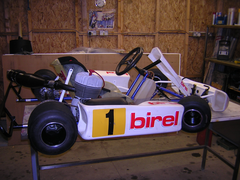minidoido
|
| posted on 23/1/08 at 12:55 PM |

|
|
Fuel Tank Test
Hi!
I've build an aluminium fuel tank, and now I need to test it.
Has anyone ever made this leakage test? What pressure should be used? etc...
Thanks!
[Edited on 23/1/08 by minidoido]
|
|
|
|
|
tegwin
|
| posted on 23/1/08 at 12:58 PM |

|
|
Unless you are planning to run the tank under pressure....
Fill it with hot water and stand it on kitchen roll and see if anything comes out.....
Thats what I would do...
|
|
|
NS Dev
|
| posted on 23/1/08 at 01:16 PM |

|
|
yep, or for a pressure test, fill with water or immerse in water, with all bar one orifice plugged, then gently blow into the last hole with an
airline blowgun, using some rag to seal it very crudely and not too tightly into the hole.
Retro RWD is the way forward...........automotive fabrication, car restoration, sheetmetal work, engine conversion
retro car restoration and tuning
|
|
|
Angel Acevedo
|
| posted on 23/1/08 at 03:04 PM |

|
|
You could attach a long hose and raise the water level above head, that will suffice.
6 ft will yield 2.47 psi
Beware of what you wish.. for it may come true....
|
|
|
DarrenW
|
| posted on 23/1/08 at 03:20 PM |

|
|
i used to work for a company that made fuel tanks for JCB's etc. They tested them just as NSDev says. Not much pressure needed. They held the
pressure for a few moments and observed any drop (as well of course any bubbles).
Other method was to stand the tank on a bench. Apply pressure and soap the joints, takes longer but just as effective.
|
|
|
minidoido
|
| posted on 23/1/08 at 03:53 PM |

|
|
ok!
Thanks!
|
|
|
IDONTBELEIVEIT
|
| posted on 23/1/08 at 07:06 PM |

|
|
hi, i manufacture these we use a dye penetrant and developer, water washable bright red dye you spray inside then spray a white powder around all the
welds leave to stand 20/30 mins and hopefully it doesent bleed through wayno!!!!
 
Rescued attachment DSCN1317.JPG
|
|
|













